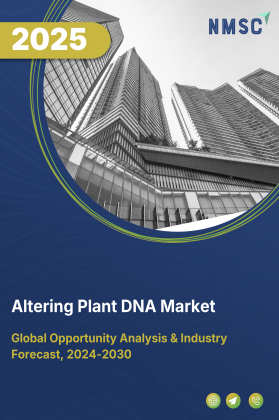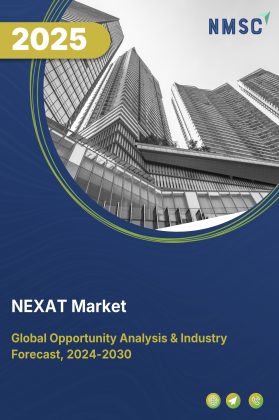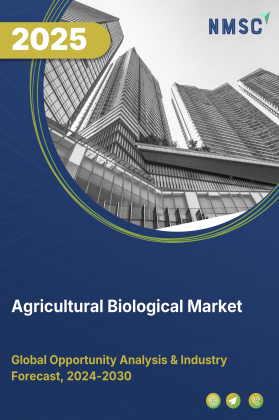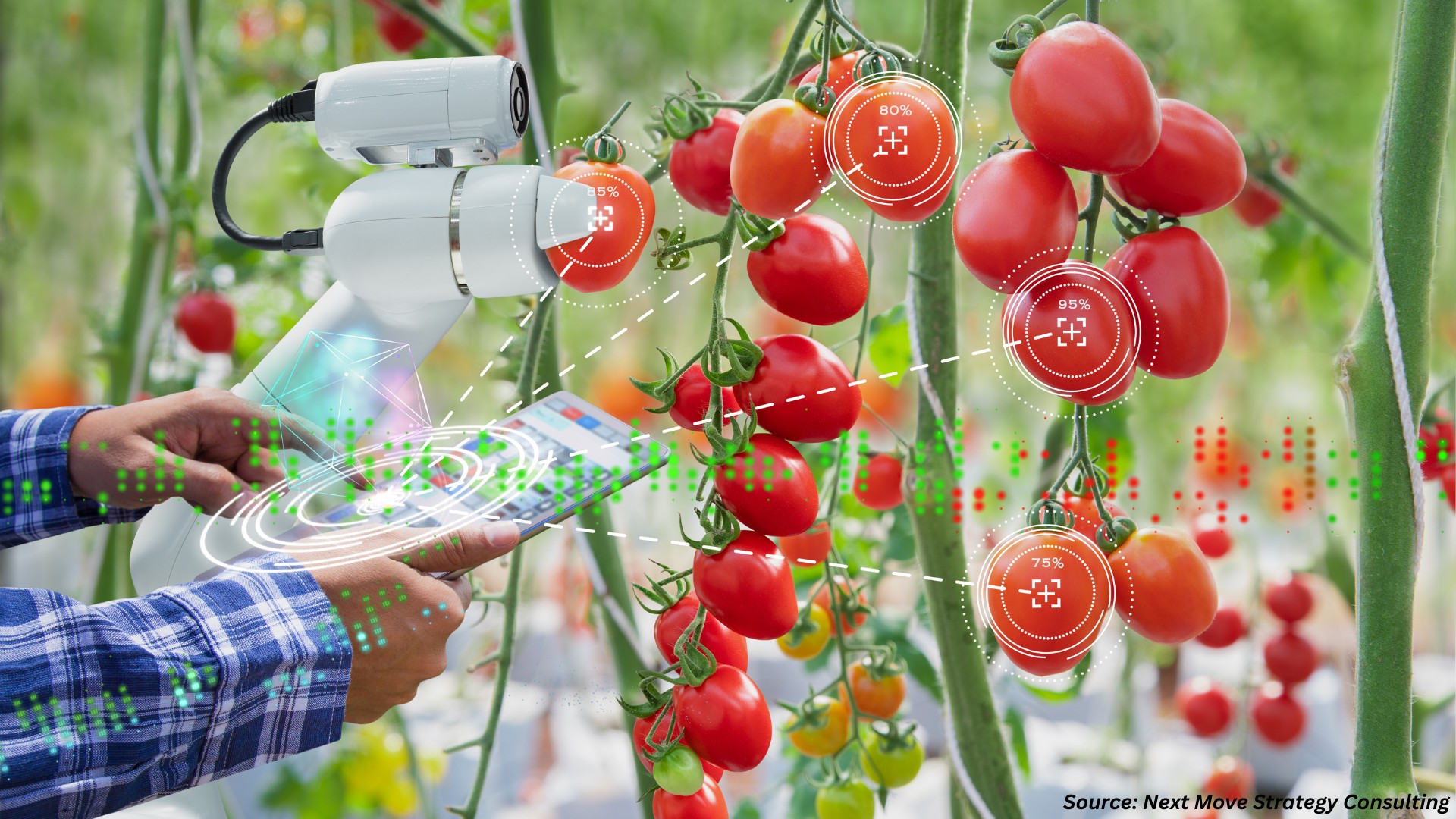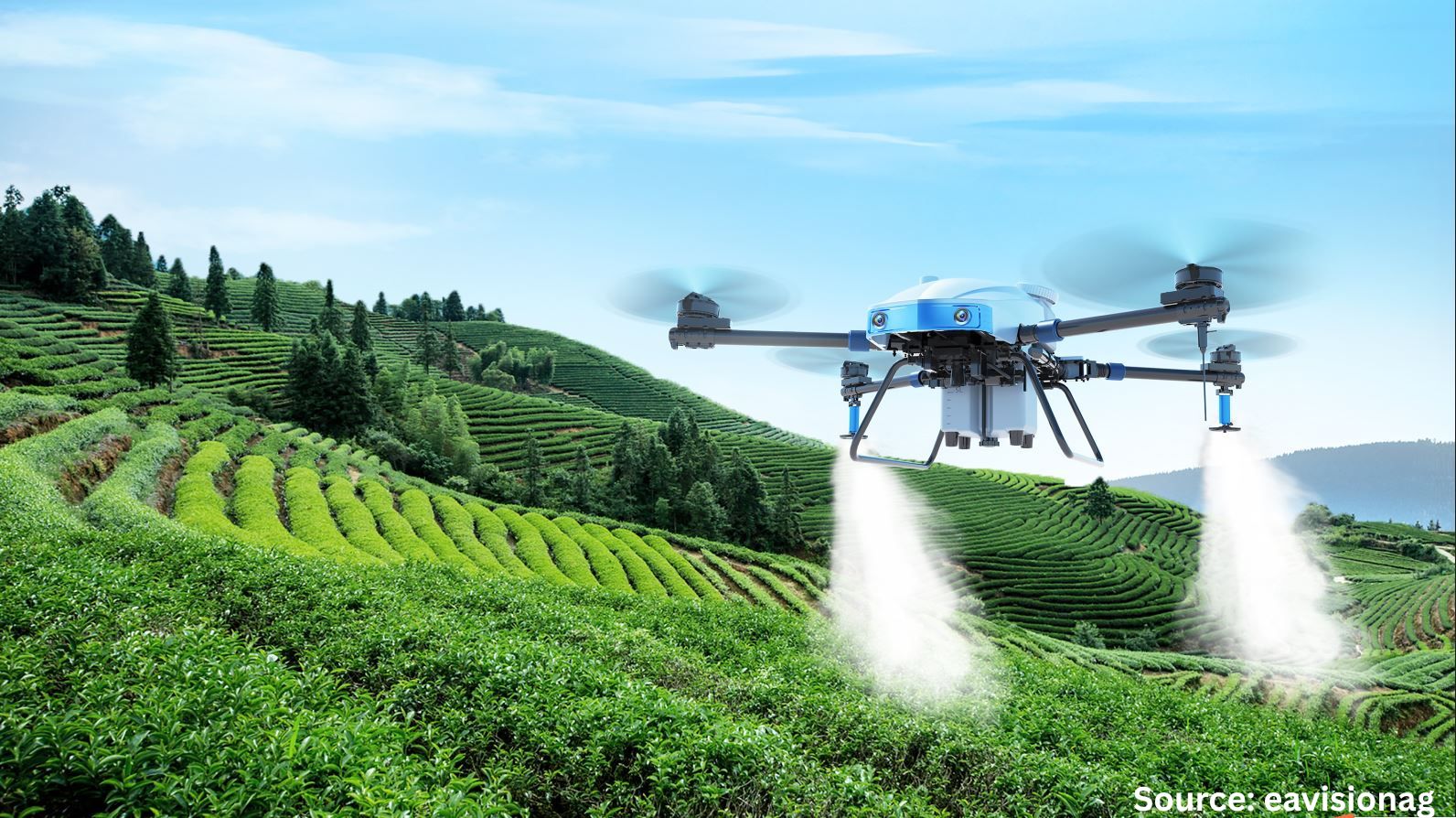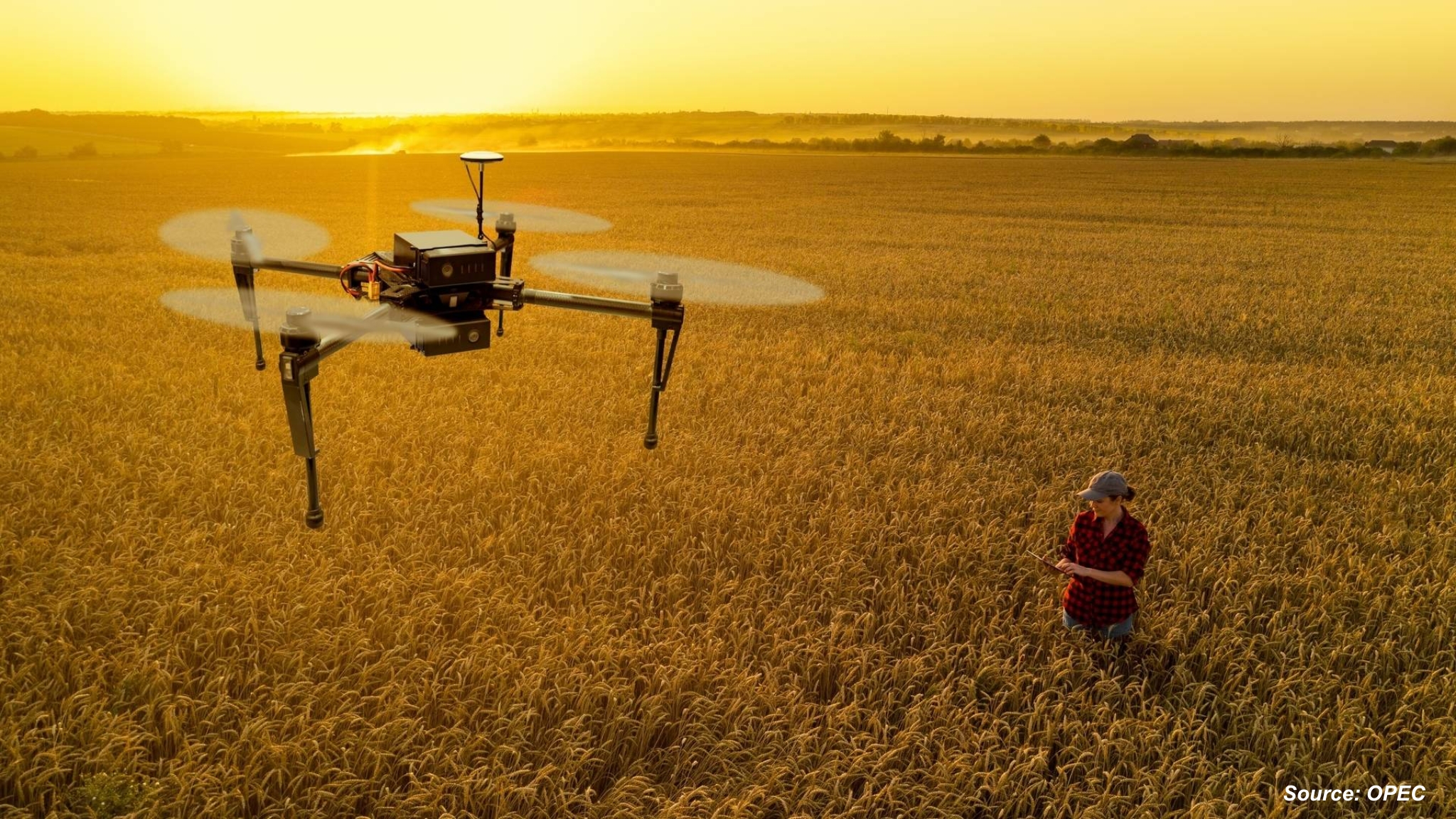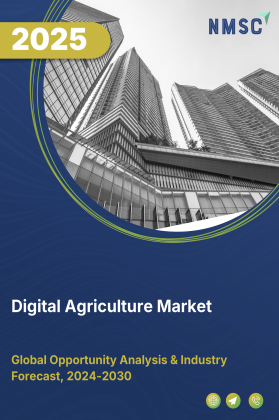
Digital Agriculture Market By Technology (Hardware (Sensor, Drones and Others), Software, Services and Others), By Business Model (Product Based (Hardware and Software, Licenses), and Service Based), By Application (Yield Monitoring, Field Mapping, Crop Monitoring, and Others), and By Deployment Mode (Cloud, On-Premises, and Others), By End-User (Large Scale Commercial Farms, Smallholder Farmers and Others) – Global Opportunity Analysis and Industry Forecast 2024-2030.
Industry Overview
The global Digital Agriculture Market size was valued at USD 28.56 billion in 2024, and is expected to be valued at USD 32.20 billion in 2025. The industry is projected to grow, reaching USD 58.64 billion by 2030 with a CAGR of 12.74% between 2025-2030.
The market is experiencing robust growth driven by the rising adoption of IoT-based real-time monitoring systems that enhance precision farming. Government-led digital initiatives and funding programs are playing a crucial role in accelerating technology integration across both developed and emerging economies.
However, adoption is restrained by infrastructure challenges, high costs, and digital literacy gaps in rural regions. Despite these hurdles, the emergence of data-efficient mobile applications and open-source tools presents scalable opportunities to support smallholder farmers and bridge the digital divide, fostering more inclusive and sustainable agricultural practices.
Increasing Use of IoT for Real-Time Farm Monitoring Enhances Precision and Efficiency in Agriculture
Farmers are increasingly integrating IoT devices to capture on field data and automate routine tasks. Real time sensors measure soil moisture, temperature, and nutrient levels, allowing more precise irrigation and fertilization schedules.
For instances, companies such as Teralytic have introduced advanced soil probes that relay multi parameter readings via cloud dashboards, while the NSF funded IoT4Ag consortium is pioneering biodegradable leaf and soil sensors paired with ground robots to broaden access in remote regions. These innovations are reducing input waste and improving yields.
Government Digital Initiatives Drives Market Growth in Agriculture Technology
Robust government initiatives are playing a transformative role in accelerating the adoption of agriculture technology across both developed and emerging economies. For example, the Food and Agriculture Organization, launched its Digital Villages Initiative in April 2024 under the FDiVi project. The initiative aims to digitize rural agricultural ecosystems in sub-Saharan Africa by equipping around 150 farmer groups in Malawi, Rwanda, and Zimbabwe with mobile advisory platforms, AI-enabled chatbots, and tablets.
Such efforts reflect a broader trend wherein governments and development organizations are embedding digital public infrastructure into national agricultural strategies. This not only enhances operational efficiency and data transparency but also creates an enabling environment for private sector innovation in farm management platforms, remote sensing, IoT-based soil monitoring, and digital marketplaces.
Government Grants are Accelerating the Adoption of Digital Agriculture
Government grants are pivotal in driving agtech uptake. National and regional authorities are rolling out substantial subsidy and grant schemes to lower the cost of adopting digital farming technologies. For example, in April 2024 the U.S. Department of Agriculture earmarked USD 1.5 billion through its Conservation Innovation Grants and SBIR STTR initiatives to help farmers, ranchers and forest landowners integrate conservation and climate smart tools, ranging from IoT sensors to precision application equipment.
Limited Connectivity, High Costs, and Digital Literacy Gaps Restrain Market Adoption
Limited connectivity, high costs and digital literacy gaps continue to restrain the digital agriculture market expansion. In many rural areas, unreliable internet and spotty electricity supply hinder the consistent use of IoT sensors and cloud based platforms.
Steep upfront investments in AI powered advisory tools and advanced sensor systems put them out of reach for cash strapped farms. And without solid digital skills or well integrated support networks, farmers struggle to deploy, maintain or integrate these technologies into their day to day operations.
Data-efficient Mobile Apps and Open-Source Tools Offer Scalable Growth Opportunities
The increasing availability of data-efficient mobile applications and open-source digital platforms is unlocking scalable opportunities to transform smallholder agriculture globally. These solutions enable cost-effective delivery of critical services such as irrigation planning, groundwater monitoring, and crop advisory support even in regions with limited connectivity and infrastructure.
By leveraging lightweight app designs and interoperable open-source tools, such platforms can reach millions of farmers at near-zero marginal cost, fostering more inclusive access to precision agriculture. As these technologies evolve, they offer a powerful pathway to bridge the digital divide, enhance resilience to climate stress, and improve productivity across diverse agro-ecological landscapes. A strong example of this trend is IBM’s My FarmWell app in the MENA region, which uses minimal data to provide sustainable farming insights to water-stressed communities.
Market Segmentation and Scope of the Study
The digital agriculture market report is segmented on the basis of technology, business model, application, deployment mode, and region. On the basis of technology, the market is divided into hardware, software, services, and others. On the basis of business model, the market is segmented into product-based and service-based. On the basis of application, the market is divided into yield monitoring, field mapping, crop monitoring, livestock monitoring, real-time safety testing, soil monitoring, precision farming, and others. On the basis of deployment mode, the market is grouped into cloud, on-premises, and others. On the basis of end-user, the market is segmented into large scale commercial farms, smallholder farmers and others. Regional breakdown and analysis of each of the aforesaid segments includes regions comprising of Asia-Pacific, North America, Europe, and RoW.
Geographical Analysis
North America’s digital agriculture market share is seeing rapid advances in both equipment and connectivity across the U.S., Canada, and Mexico. North America sees the growth with adoption driven by large-scale industrial agriculture, high infrastructure readiness, and proximity to major Agriculture-equipment OEMs and startup innovation.
For example, in May 2025, Deere strengthened its market expansion by acquiring a leading drone imaging firm, integrating high resolution aerial scouting and advanced analytics into its operations platform for more precise crop monitoring and input management.
Europe’s growth in the market is underpinned by a strong regulatory framework (Green Deal, CAP subsidies) and national funding schemes in over half of EU countries, which together drive precision‐farming adoption by some of the growers. High uptake of IoT devices and collaborative data‐sharing platforms, alongside robust research networks, further accelerate innovation and sustainability across European farms.
Europe’s digital farming scene also thrives on collaboration between established agribusinesses and innovative tech providers. In March 2024, Bayer brought its xarvio Field Manager platform to the Science Behind Digital Agriculture conference, demonstrating advanced seed placement algorithms and live crop monitoring capabilities.
Asia Pacific’s digital agriculture realm is seeing accelerated uptake of advanced drone platforms and digital farm management tools tailored to local operations. The growth is also driven by the urgent need to boost food output for its large rural population and strong government initiatives promoting rural digitization and sustainability.
For example, on April 25, 2024, DJI launched its Agras T50 and T25 drones globally alongside an upgraded SmartFarm app, offering payload capacities up to 50 kg and streamlined aerial application management for both large estates and smallholdings.
Emerging markets in Latin America, the Middle East, and Africa (RoW) are rapidly adopting digital solutions, supported by public–private partnerships and development finance. In Brazil, Embrapa and Jacto launched a precision agriculture inclusion project for smallholders in July 2024. While FAO’s FDiVi Digital Villages initiative launched April 2024, empowers over 150 farmer groups in Malawi, Rwanda, and Zimbabwe with tablets and AI chatbots for advisory services.
Strategic Innovations Adopted by Key Players
The digital agriculture industry is rapidly advancing through AI integration, satellite connectivity, and digital service innovations. Recent developments focus on enhancing real-time decision-making, expanding dealer networks, improving rural internet access, and enabling data-driven farming-driving efficiency, sustainability, and deeper farmer engagement across global markets.
-
In 2025, CNH unveiled an AI‑powered sprayer integrated across Case IH, New Holland, and Miller portfolios, using machine‑learning and camera sensing to automate real‑time crop analysis and targeted spraying, cutting input costs and improving yields. More recently (May 2025), CNH partnered with SpaceX’s Starlink to deliver high‑speed satellite internet to remote farms, embedding connectivity into its FieldOps and FieldXplorer platforms. This collaboration closes rural connectivity gaps and strengthens CNH’s digital‑services ecosystem, enhancing brand stickiness and unlocking new precision‑ag revenue streams.
-
In May 2025 AGCO accelerated PTx dealership expansion across North America, tripling dealer coverage to deliver its Farmer First precision portfolio and targeting $2 billion in precision ag sales by 2029. These steps bolster AGCO’s tech leadership, deepen customer engagement, and drive sustained market share growth
-
In February 2025, Texas A&M AgriLife and IBM debuted SWAT VEXA, a generative AI Virtual Extension Assistant that democratizes soil‑and‑water decision‑making via big‑data AI to accelerate policy, research, and on‑farm actions. This digital service innovations elevate IBM’s brand as a sustainability‑focused tech partner and expand its footprint in ag‑tech consulting.
-
In April 2024, CNH Industrial partnered with Intelsat to improve network connectivity for precision agriculture customers. This partnership will leverage Intelsat’s satellite technology to enhance data access and real-time information exchange, optimizing agricultural operations and supporting sustainability. Additionally, it aims to expand the reach of CNH’s digital platforms, improving user experiences in the agricultural sector.
-
In November 2022, AGCO Corporation introduced Geo-Bird, an innovative online application aimed at helping farmers globally design and optimize their machine guiding lines for the Global Navigation Satellite System. This tool enables autonomous adjustments, enhancing operational efficiency and precision in agricultural practices.
Key Benefits
-
The report provides quantitative analysis and estimations of the industry from 2025 to 2030, that assists in identifying the prevailing digital agriculture market opportunities.
-
The study comprises a deep-dive analysis of the current and future digital agriculture market trends to depict prevalent investment pockets in the market.
-
Information related to key drivers, restraints, and opportunities and their impact on the market is provided in the report.
-
Competitive analysis of the players, along with their market share is provided in the report.
-
SWOT analysis and Porters Five Forces model is elaborated in the study.
-
Value chain analysis in the market study provides a clear picture of roles of stakeholders
Digital Agriculture Market Key Segments
By Technology
-
Hardware
-
Sensors
-
Drones
-
Robotics
-
GPS Devices
-
Others
-
-
Software
-
Services
By Business Model
-
Product Based
-
Hardware
-
Software licenses
-
-
Service Based
-
Data analytics subscriptions
-
Consulting and advisory
-
By Application
-
Yield Monitoring
-
Field Mapping
-
Crop Monitoring
-
Livestock Monitoring
-
Real-Time Safety Testing
-
Soil Monitoring
-
Precision Farming
-
Others
By Deployment Mode
-
Cloud
-
On-Premises
-
IoT and sensor driven systems
-
Remote sensing systems
By End User
-
Large Scale Commercial Farms
-
Smallholder Farmers
-
Agribusinesses & Processors
-
Government and NGOs
By Region
-
North America
-
The U.S
-
Canada
-
Mexico
-
-
Europe
-
The UK
-
Germany
-
France
-
Italy
-
Spain
-
Denmark
-
Netherlands
-
Finland
-
Sweden
-
Norway
-
Russia
-
Rest of Europe
-
-
Asia-Pacific
-
China
-
Japan
-
India
-
South Korea
-
Australia
-
Indonesia
-
Singapore
-
Taiwan
-
Thailand
-
Rest of Asia-Pacific
-
-
Rest of the World
-
Latin America
-
Middle East
-
Africa
-
Key Players
-
DroneDeploy
-
Trimble Inc.
-
Raven Industries
-
Bayer AG
-
Climate LLC.
-
BASF Digital Farming GmbH
-
Farmers Edge Inc
-
AgriWebb
-
AgGateway
-
CropX Inc.
-
Bushel Inc
-
Cropin Technology Solutions Private Limited
-
AGCO Corporation.
Report Scope and Segmentation
|
Parameters |
Details |
|
Market Size in 2025 |
USD 32.20 Billion |
|
Revenue Forecast in 2030 |
USD 58.64 Billion |
|
Growth Rate |
CAGR of 12.74% from 2024 to 2030 |
|
Analysis Period |
2024–2030 |
|
Base Year Considered |
2024 |
|
Forecast Period |
2025–2030 |
|
Market Size Estimation |
Billion (USD) |
|
Growth Factors |
|
|
Countries Covered |
28 |
|
Companies Profiled |
15 |
|
Market Share |
Available for 10 companies |
|
Customization Scope |
Free customization (equivalent to up to 80 working hours of analysts) after purchase. Addition or alteration to country, regional, and segment scope. |
|
Pricing and Purchase Options |
Avail customized purchase options to meet your exact research needs. |

















 Speak to Our Analyst
Speak to Our Analyst



